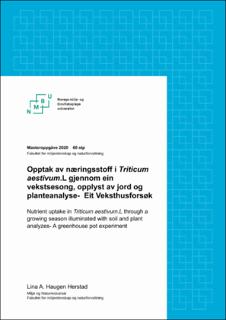| dc.contributor.advisor | Krogstad, Tore | |
| dc.contributor.advisor | Næss, Thorgeir | |
| dc.contributor.author | Herstad, Lina Andrea Haugen | |
| dc.date.accessioned | 2021-03-18T13:04:36Z | |
| dc.date.available | 2021-03-18T13:04:36Z | |
| dc.date.issued | 2020 | |
| dc.identifier.uri | https://hdl.handle.net/11250/2734249 | |
| dc.description.abstract | I dette forsøket blir AL-metoden og CaCl2 samanlikna med kvarande og med planteopptak i vårkveite (Triticum aestivum) for Fosfor (P), Kalium (K) og Magnesium (Mg), i et forsøk på å finne korrelasjon med buffernæring, intensitet i jorda og planteopptak i en vekstsesong. Uttak ble tatt på sju ulike tidspunkt i vekstperioden for å vise planteoptakk. To ulike sedimenta blei bruk for får differensiere effekten av fysiske eigenskapar i jorda og kunne representere typisk landbruksjord. Forsøket ble utført i et veksthus,med tre behandlingar for å forklare jorda intensitet og adsorpsjon i en vekstsesong; fullgjødsling og vårkveire, fullgjødsel utan vårkveite og ubehandla jord. Korrelasjonen mellom AL- og CaCl2 – verdiane frå dei sju uttaka viser at best til dårligast R2 i dyrka jord: K-lettleire> K-Sandig lettleire > Mg-lettleire > Mg-sandig lettleire > Psandig lettleire > P-lettleire. Forskjellen mellom verdiane i «kontroll gjødsla» og «dyrka jord» i begge jordartane med begge metodane kan tyde på at endringa P-K og Mg-buffer og intensitet i i jorda over en vekstsesong ikkje kunn kan skyldast næringsopptak i planten men andre prosessar og mikroorganismar som binde og bruke næring i jorda som kan påverke forhaldet mellom metode og planteopptak. | en_US |
| dc.description.abstract | In this experiment, the AL method and CaCl2 are compared with quarantine and with plant uptake in spring halibut (Triticum aestivum) for Phosphorus (P), Potassium (K) and Magnesium (Mg), in an attempt to find a correlation with buffer nutrition, intensity in the soil and plant uptake during a growing season. Withdrawals were taken at seven different times during the growth period to show plant uptake. Two different sediments were used to differentiate the effect of physical properties in the soil and could represent typical agricultural soil. The experiment was performed in a greenhouse, with three treatments to explain the soil intensity and adsorption in a growing season; complete fertilization and spring halibut, complete fertilizer without spring halibut and untreated soil. The correlation between AL and CaCl2 values from the seven extractions shows that the best to worst R2 in cultivated soil: K-light clay> K-Sandy loam> Mg light clay> Mg-sandy loam> P-sandy loam> P-light clay. The difference between the values in «control fertilizer» and «cultivated soil» in both soil types with both methods may indicate that the change PK and Mg buffer and intensity in the soil over a growing season cannot be due to nutrient uptake in the plant but other processes and microorganisms that bind and use nutrients in the soil that can affect the relationship between method and plant uptake. | en_US |
| dc.language.iso | nno | en_US |
| dc.publisher | Norwegian University of Life Sciences, Ås | en_US |
| dc.rights | Attribution-NonCommercial-NoDerivatives 4.0 Internasjonal | * |
| dc.rights.uri | http://creativecommons.org/licenses/by-nc-nd/4.0/deed.no | * |
| dc.title | Opptak av næringsstoff i Triticum aestivum.L gjennom ein vekstsesong, opplyst av jord og planteanalyse : eit veksthusforsøk | en_US |
| dc.title.alternative | Nutrient uptake in Triticum aestivum.L through a growing season illuminated with soil and plant analyzes : a greenhouse pot experiment | en_US |
| dc.type | Master thesis | en_US |
| dc.description.localcode | M-MINA | en_US |

